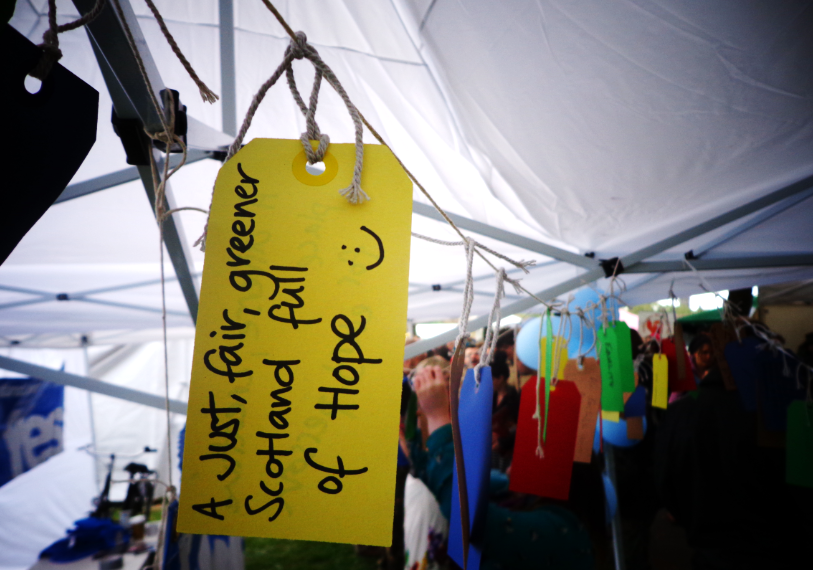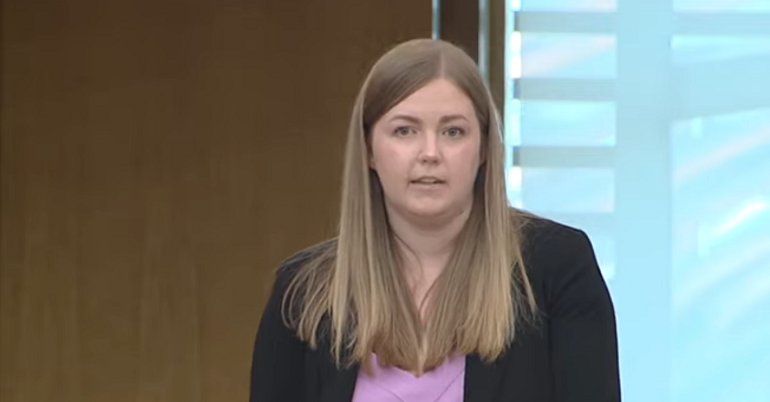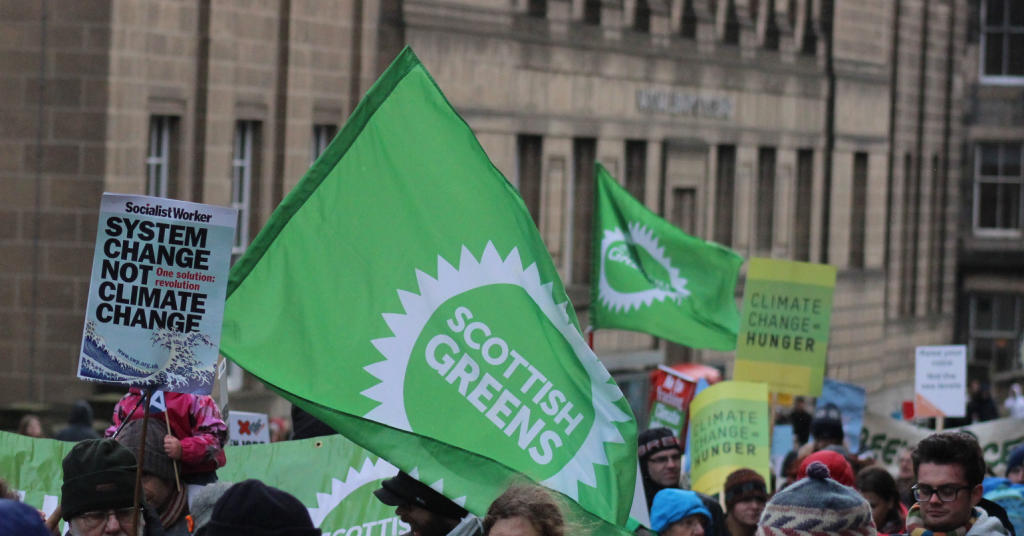Devo-Max was a perfect example of rotten Westminster politics
The referendum is over, and the no’s have won. With Cameron and Miliband trying to decide exactly what the no’s have won, now is a good time to very briefly take stock and think a little about what has happened over the last few weeks since that poll that put Yes in front, before ploughing on and trying to make the most out of any constitutional crisis.
This was a campaign of multiple dichotomies – not just between independence and the union but between idealists and pragmatists, between interventionism and internationalism, between different identities, between two radically different concepts of nationalism. But I think very significantly there was also a dichotomy between two very distinct styles of political activity.
The yes side, particularly the left wing of the yes side, was characterised by a highly participative style of politics. There were public meetings every night up and down the country where members of the public weren’t just spoken at, but where they instead actively took part. Radical Independence held two enormous conferences bringing together thousands of activists who otherwise would have never sat in the same room, and groups were invited to run workshops and capture discussion. RIC in Edinburgh held fortnightly planning meetings so everyone could decide on the future of the campaign. Yes stalls and events across the country were characterised by ‘wish trees’ – washing lines that the public adorned with their hopes for how an independent Scotland could be different. Yes voters were transformed relatively easily into yes campaigners through their signing of the declaration, and that shows! Yes campaigners far outnumbered no campaigners at every turn. Yes Scotland itself was run in an incredibly decentralised way – local campaigns were organised locally with material support from the centre. And that’s not even to mention the hundreds of autonomously organised campaign groups from National Collective through to English Scots for Yes and People With Third Nipples For Yes (probably). Ordinary people drove the campaign, and ordinary people drove the narrative of the campaign. If Alex Salmond had for some reason wanted to stop the campaign, he couldn’t have done it.

Although it may not have been conscious, this was a reaction to Westminster politics. The no campaign was run not at all unlike a parliamentary election campaign. It was driven and controlled largely from the centre and as a result there was a much reduced number of campaigners out on the streets. I got 5 leaflets through my door from the no campaign during the past 2 years, and three of them were from mailshots. At my flat we got 3 yes canvassers and none from no. Better Together were hiring people to do tasks which volunteers were queueing up to do for Yes Scotland. The no campaign consisted largely of orchestrated media set pieces. Week after week, news stories were put into a friendly media, and a lot of them were simply announcements by ministers, or by businesses closely linked to the Westminster establishment. This was a technocratic campaign largely conducted from the top, using connections in the media to get a polished message out. It was run in exactly the same way politics is run in Westminster.
It wasn’t always this way. Political parties used to create the demographics which voted for them, they convinced people that they were right, they politicised people, they were the parliamentary representation of political movements, connected to real people. But the last time a political party did any of these things effectively at Westminster was probably when Thatcher brought in Right to Buy and created a generation of people whose material interests were tied up with hers. Now people are treated like diners at a terrible buffet, forced to choose between options they don’t like which barely differ from one another, and with little opportunity to make anything new themselves. It’s exactly this alienation that Jimmy Reid spoke of in his famous rectorial address, an alienation which led to the referendum in the first place.
Devo-max was the ultimate example of translating the failed Westminster model of politics onto Scotland. Facing a choice between the option of staying within the union or becoming independent, the three unionist parties examined the polls and all dove into the middle ground, they all triangulated. (The SNP did it too, leading to three of what I consider the major weaknesses of the Yes Campaign’s strategy – their proposal to keep the monarchy and the pound, and to maintain their membership of NATO.) Devo-Max was a particularly half-arsed proposal, vaguely defined, poorly thought through, proposed in a way which meant no one could scrutinise it and, as we’ve seen since the result of the referendum, not even agreed upon by the leaders of the major parties, never mind their MP’s. Even its name is terrible, a new-fangled hyphenated contraction where ‘Home Rule’ would have done just fine. No doubt it was concocted in a focus group.
Treating the electorate in this way, like consumers rather than participants, is the model of politics which brought about UKIP, the Alternative Vote referendum and Labour’s proposal for £6k fees. Now it’s forced the Westminster parties to promise something they can’t deliver, and once again alienate a huge proportion of people in Scotland.



See below for a view on the tax implications of devo max. By the way I live 3 miles over the Tweed and was a yes vote.
Proposals for Devo Max in Scotland subsequent to the failure of independence in the recent referendum, emphasise the ability of the Scottish government to develop increased tax-raising powers. It’s important to recognise that the Scottish government has virtually complete control over the form of education and health in Scotland and control over those aspects of welfare which are not part of the income maintenance system. As things stand at present these are funded primarily through an allocation of capital United Kingdom central government expenditure determined by the Barnett formula. This allocates higher proportion of overall tax raised revenues to Scotland than would be justified on the needs basis for allocation (see Byrne 2011). The only other source of Scottish government revenue is council tax which is raised by and allocated to local authorities. This has been frozen since??? in Scotland and this, like the failure of any Scottish government to use the very limited tax-raising powers in relation to income which already exist, indicates the timidity of Scottish governments of all political persuasions in relation to increasing taxation.
As I have argued previously (Byrne 2011) the primary beneficiaries of the higher level of public spending in Scotland have been Scottish middle classes through free university education for their children, higher expenditure on secondary education, higher expenditure on healthcare (the Scottish were notoriously die young and cheaply), and considerably reduced costs for those requiring domiciliary or residential care in old age. The results of the referendum seem to indicate that it was precisely the relatively comfortable who voted no. Certainly this is the only inference that we can draw from the geographical pattern of voting. Because other factors were of significance, but the relationship between marginalisation and yes voting was very clear.
The overall pattern of voting is interesting when we consider the implications of Devo Max. It seems almost certain that any move towards Devo Max will involve a recalculation or even abandonment of the Barnett formula. This means that higher Scottish public expenditure will be dependent on higher Scottish taxation. Attention has tended to be directed towards taxes on oil revenues and corporation tax. It is always important to remember that corporation taxes yield a relatively small proportion of UK tax revenue in that whilst oil revenues do matter, there is no indication that Devo Max will include the allocation of that element of government revenue to Scotland alone. It is highly to be Scotland’s oil. This means that revenues must be raised essentially from taxes on income and domestic property since it is both unlikely and impractical for taxes on consumption and in particular V A T to be varied within what will remain a single consumption market in the UK. Unless, and this is highly unlikely, National Insurance benefits are allowed to vary within the UK, then the scope for variation in national insurance seems at best limited and in all probability non-existent. So the focus will be on income tax and council tax also successor property tax. Now the problem with income tax is that for the very affluent it is essentially a voluntary payment. Much of the so highly vaunted financial services sector devotes its activity precisely to enabling the very high paid, and in particular the top 1% of income earners (or more precisely households in the top 1% of the household income bracket) to minimise their tax payments. This means that increases in income tax are in practice likely to fall most severely on households and individuals who are in the top 20% plus of the income distribution but not in the most affluent section. This is particularly the case because differential rates of tax between Scotland and England provide a bonanza for tax lawyers and accountants serving the needs of the hyper- affluent. This is also where the impact of increased property taxes will also fall, although at least here properly constituted property tax system would actually have a real impact on the very affluent. Indeed there is a very strong argument for immediately developing a new property tax system in Scotland. This would not only an impact on domestic property but could also be so devised that it would fit very hard the large landowners and in particular the owners of sporting estates. However, desirable as this would be the main source of income from a properly constituted property tax would be houses.
In a rational society the consequent impact of this on house prices would be welcomed. However, the UK housing market lost touch with rationality a generation ago at least. Nonetheless, taxing the taxing the affluent homeowners of Edinburgh until the pips squeak has many political advantages. Not least it might have a serious impact on private education in that city, and indeed in Glasgow even, which is one of the major sources of inequality in Scottish society today. Extended to Glasgow it would even hit the current deputy leader of Scottish Labour who is so committed to familial retention privilege that he senses own children to private schools.
If Scotland is to continue to maintain its present pattern of expenditure on education, health and social care, then the Scottish middle-class will have to pay for it. In an ideal world the Scottish plutocrats, the top 1% who are moving away from everybody else, would be subject to proper levels of taxation. However this is unlikely in a merely devolved Scotland. Of course since it is the Scottish middle-class benefit from present patterns of expenditure, then it might be considered to be only fair that they should pay for them. Indeed, given that they voted no, those of us who voted yes in the hope that a new radical Scotland could be created in an independent nation might consider they are getting their just deserts. The crucial point is that Devo Max Scotland with taxation powers is quite likely to face a serious revenue versus expenditure crisis in the very near future.
David Byrne-resident 3 miles over the Tweed and yes voter.
D. S. Byrne (2011) ‘the over subsidised periphery-who benefits?’ Radical statistics 97
Mike: Jane genuine question – why in your view is the currency union with an independent Scotland significantly worse than the currency arrangements as they currently exist?
I wrote about this more extensively on my own blog (https://edinburgheye.wordpress.com/tag/currency-union/) but in condensed form:
1. At present, Scotland has 59 MPs at Westminster and 6 MEPs in the EU. In currency union, iScotland would have major decisions about the economy, spending, and other regulations made by Westminster/City of London/European Parliament, but would have no MPs and no MEPs.
2. iScotland in currency union as designed by the SNP/FCWG would have no central bank: therefore, couldn’t qualify for EU membership. No doubt the EU would have worked out some special arrangement for iScotland to remain inside the EU as a dependent territory of rUK (there are several other such special arrangements) but this couldn’t include voting rights. (hence no MEPs).
3. Currency union would have had to have been legislated at Westminster in negotiation with the Bank of England, with spending and borrowing limits for the Scottish government potentially far more restricted than in the present arrangement of block grant/devolved areas.
Thanks for that.
Matt
I’ve been trying to keep track of new joiners to Scottish Greens via their postings on Twitter. Now I know these will tend to the young and/or IT literate but it’s all I have to go on.
There are people moving over from Labour – actively resigning from Labour and joining us. Some are pretty high profile people. Labour certainly have a problem.
There are the ‘alternatives’ – the eco-warrior, modern hippy, home schooling, anti-establishment.
And then the vast majority seem to be a mix – every part of Scotland, every walk of life (judging from their twitter profiles). Mix of gender, sexual orientation, …
All are united in a commitment to continue in a postive direction for Scotland – but I guess they are seeing the Green participative, inclusive approach – and some of our challenges to the ‘conservative’ vision of the SNP – as attractive.
Sorry for a third post – missed a bit.
If your recruits are more from Scottish -abour, then I think it is more optimistic for the Scot Greens.
btw – my keyboard has a dead key.
OK. Got my number from the FT:
http://www.ft.com/cms/s/0/44179c94-41a1-11e4-b98f-00144feabdc0.html#axzz3Dya1ryuK
Scottish Greens about 2000 a week ago and maybe ending up with 5000 in a few days.
I am interested in who they are, and what the impact may be.
If you are picking up the type of Turbo-Nats who are signing these petitions grasping at conspiracy theories and b-aming everbody except the one they can see in the mirror … interesting times.
Mike
Not sure where to put it this q but is the a number for Scottish Green membership before the weekend surge?
Thanks
Jane genuine question – why in your view is the currency union with an independent Scotland significantly worse than the currency arrangements as they currently exist?
And yet, I found it quite literally impossible to get any Yes campaigner (well, with a tiny number of honourable exceptions) to defy the SNP’s plans and come out against currency union.
Even the Yes campaigners who said they didn’t support currency union wouldn’t campaign against it. People handwaved the problem of the SNP planning to create a permanent tie between iScotland and Westminster / Bank of England / City of London – a bond without any democratic control at the Scottish end, that would block iScotland from joining the EU – as if it were a tiny unimportant issue.
I voted No because it seems to me that it was the only way to stop the SNP installing currency union. The downside of this is that I shall never know for sure if I was right. The upside is that I don’t have to spend the next 18 months fighting an unwinnable fight against currency union, and the next twenty years watching all of the things I’d predicted come true while people who’d told me not to worry anguished “how could we have known?”
I am deeply relieved No got the majority. I hope next time there’s an independence referendum, the lesson learned is: more planning, less idealistic handwaving.
It was vaguely defined and therefore not open to scrutiny and had a lot of deliberate omissions. Asking a question about the referendum = scaremongering. That’s not being open to scrutiny.
A 300-odd page white paper is ‘vaguely defined’ and ‘proposed in a way which means noone could scrutinise it’? People DID scrutinise it. For a year.
“Devo-Max was a particularly half-arsed proposal, vaguely defined, poorly thought through, proposed in a way which meant no one could scrutinise it and, as we’ve seen since the result of the referendum, not even agreed upon by the leaders of the major parties, never mind their MP’s.”
This could almost be said, word for word, of independence.